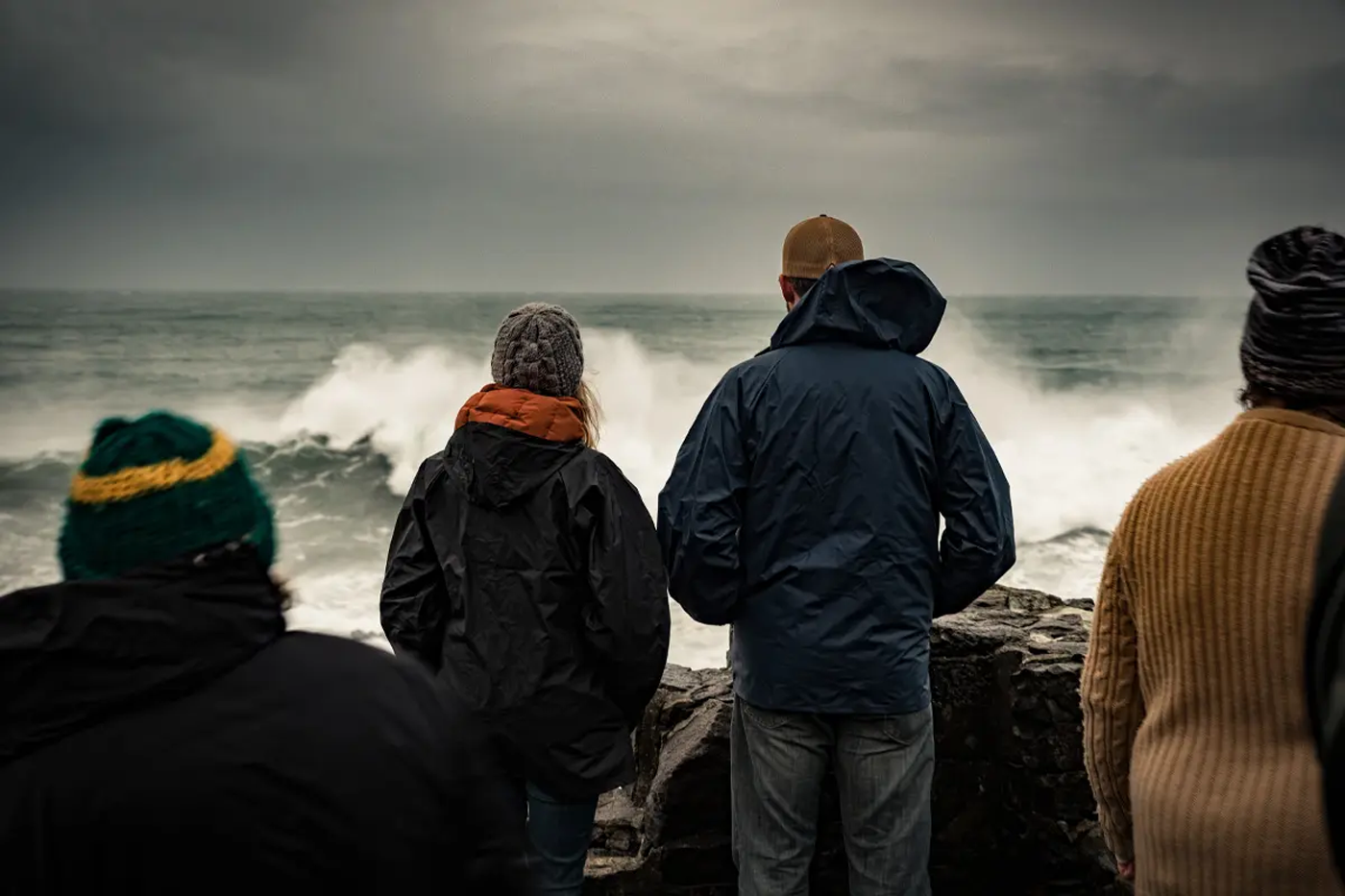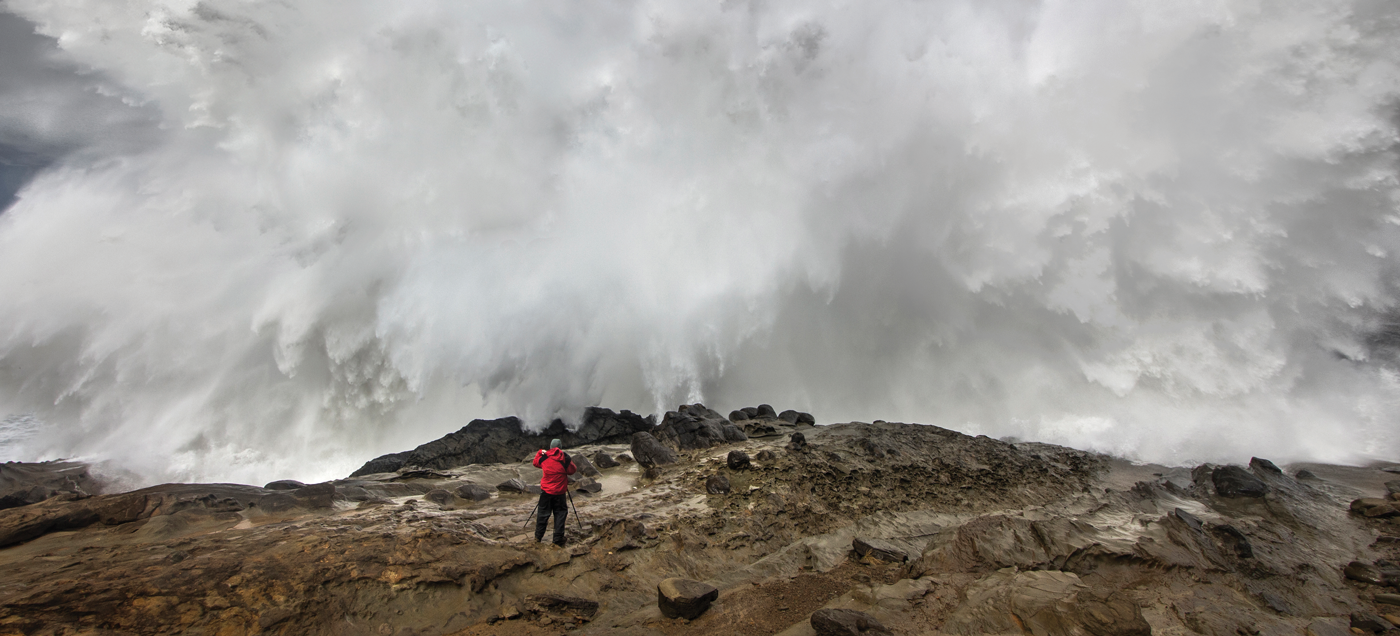Eighty feet above the churning Pacific Ocean, the walled clifftop viewpoint at Shore Acres State Park just outside of Coos Bay offers an ideal spot to watch winter storms. It’s home to huge Oregon Coast waves, which have been measured at record heights of up to 300 feet at the site. From Astoria to Brookings, the Oregon Coast offers many opportunities to view stormy waves. But the Coos Bay, North Bend, and Charleston area, just two and a half hours south of Eugene, has ideal winter storm watching, says Janice Langlinais, executive director of Oregon’s Adventure Coast.
“The North Coast is beach-level, and central is a combo of beach and cliff,” explains Langlinais. “But from Sunset Bay to Brookings, the southern coast is all cliff. We are higher above the ocean. There’s a lot of cliff faces for waves to hit.”
Prime winter storm season typically runs from late October to late March. That five-month window brings five to 12 storm-viewing opportunities, depending on how active the Pacific is. A storm can be far from shore but pushing swells 20 to 30 feet high toward the coast. That energy hits the cliff hard and fast, and sends the water spewing high into the air. The higher the swell, the bigger the wave plume: A 20-foot swell can easily become a 100-foot-high wave.

“Storms pop up willy-nilly,” says Langlinais. “We get very little notice of a storm, maybe two or three days’ notice, sometimes as little as a day and a half. As soon as we get word from the National Weather Service, we post it to our Facebook page. High surf warnings are when the swells are in the best conditions for storm watching.”
Cape Arago State Park and the bluff overlooking Bastendorff Beach are also good viewpoints. But the best place to go is the same clifftop viewpoint that’s also famous for the Oregon Coast’s record winter waves. Along the Cape Arago Highway west of Charleston, Shore Acres State Park offers ample parking, a long, walled viewpoint reached by accessible paved paths, and a splashy show.
“Most erosion on a cliff goes inland, but this particular cliff juts out,” explains Langlinais. “There’s a huge rock in front of that cliff. The waves hit that rock, come into a gully, and the water has nowhere to go but up.”

While there are other clifftop viewpoints up and down the Oregon Coast, Shore Acres is special for another reason.
“There’s no location that’s 100% safe, but this one is safer than most,” says Langlinais. “An observation building near the wall allows you to be indoors but watch the waves. The wall also gives some protection if you’re outside. If a huge wave knocks you off your feet, odds are you’ll get stopped by the wall.”
Langlinais and her team advise storm watchers to:
- Check news reports and any posted signs or messages.
- Wear warm, water-resistant layers.
- Always keep the ocean in view.
- Avoid being on or around logs.
- Stay back from cliffs.
- Never turn your back on the ocean.
- Always know your escape route to get away from the water.
After all, storm watching is not necessarily a safe endeavor, but people can take simple precautions to be as safe as possible. And the payoff is not just the sight of a plume of fierce winter wave flying in the air. It’s the feeling of being there, in the midst of such a singular, powerful experience.
“You can feel it in your chest,” says Langlinais. “There’s a roaring and rumbling as the swell comes toward the cliff, as the waves crash.”
Storm watching in the Coos Bay area
Oregon’s Adventure Coast, 50 Central Ave., Coos Bay, 541/269-0215, oregonsadventurecoast.com
Shore Acres State Park, 89526 Cape Arago Hwy, Coos Bay
Bastendorff Beach, (Clifftop viewing from parking lot in campground), Beach Road, Coos Bay
Cape Arago State Park, Cape Arago Hwy, Coos Bay


